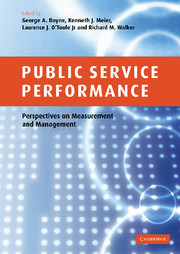Book contents
- Frontmatter
- Contents
- List of figures
- List of tables
- Notes on contributors
- 1 Introduction
- 2 Subjective and objective measures of organizational performance: An empirical exploration
- 3 All measures of performance are subjective: More evidence on US federal agencies
- 4 A qualitative evaluation of public sector organizations: Assessing organizational performance in healthcare
- 5 Quantitative approaches towards assessing organizational performance
- 6 Consequences of goal ambiguity in public organizations
- 7 Performance control and public organizations
- 8 Bureaucratic red tape and organizational performance: Testing the moderating role of culture and political support
- 9 All that glitters is not gold: Disaggregating networks and the impact on performance
- 10 Network evolution and performance under public contracting for mental health services
- 11 The design and management of performance-based contracts for public welfare services
- 12 Outsourcing government information technology services: An Australian case study
- 13 International comparisons of output and productivity in public service provision: A review
- 14 Public management and government performance: An international review
- 15 What drives global e-government? An exploratory assessment of existing e-government performance measures
- 16 Public management and organizational performance: An agenda for research
- Index
- References
9 - All that glitters is not gold: Disaggregating networks and the impact on performance
Published online by Cambridge University Press: 22 September 2009
- Frontmatter
- Contents
- List of figures
- List of tables
- Notes on contributors
- 1 Introduction
- 2 Subjective and objective measures of organizational performance: An empirical exploration
- 3 All measures of performance are subjective: More evidence on US federal agencies
- 4 A qualitative evaluation of public sector organizations: Assessing organizational performance in healthcare
- 5 Quantitative approaches towards assessing organizational performance
- 6 Consequences of goal ambiguity in public organizations
- 7 Performance control and public organizations
- 8 Bureaucratic red tape and organizational performance: Testing the moderating role of culture and political support
- 9 All that glitters is not gold: Disaggregating networks and the impact on performance
- 10 Network evolution and performance under public contracting for mental health services
- 11 The design and management of performance-based contracts for public welfare services
- 12 Outsourcing government information technology services: An Australian case study
- 13 International comparisons of output and productivity in public service provision: A review
- 14 Public management and government performance: An international review
- 15 What drives global e-government? An exploratory assessment of existing e-government performance measures
- 16 Public management and organizational performance: An agenda for research
- Index
- References
Summary
Introduction
Networks of actors rather than merely individual administrative agencies are significant in shaping the production and delivery of public policy. A burgeoning research literature proclaims as much, practical discussions on multiple continents treat the theme as important, and the academic research on networked arrays has become ever more convincing and detailed.
A dominant emphasis in this coverage has been on the value added by networked arrays over the ‘lonely organizations’ (Hjern and Porter 1982) that were highlighted in the traditional work of public administration and public management. Networks, the literature contends, enhance the avenues for dealing with wicked and complex problems that require partnerships and cooperation among public, private, and/or non-profit actors. They offer flexibility, adaptability, potential economies of scale, and greater possibilities for coproduction. They provide sensible fits for the demands of multilevel governance. Indeed, they would seem to be the institutional form of choice in an era of ‘governance, not governments’. As recent movements such as the New Public Management sputter on, networks could become an imperative of the new century's public administration.
While these points may have considerable merit, particularly under carefully stipulated conditions, they overgeneralize and overreach. In this chapter, we argue that the glittering promise of networking may not be so golden after all. Some forms of networked interaction – with particular kinds of actors under particular conditions – might well produce little or nothing, while others are simultaneously advantageous for outcomes. In the auric world of networks, all that glitters is not gold.
Information
- Type
- Chapter
- Information
- Public Service PerformancePerspectives on Measurement and Management, pp. 152 - 170Publisher: Cambridge University PressPrint publication year: 2006
References
Accessibility standard: Unknown
Why this information is here
This section outlines the accessibility features of this content - including support for screen readers, full keyboard navigation and high-contrast display options. This may not be relevant for you.Accessibility Information
- 4
- Cited by
